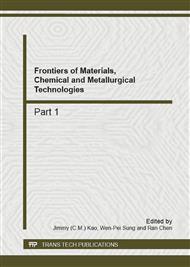p.150
p.154
p.160
p.164
p.168
p.172
p.176
p.180
p.185
Study on the Gelation Properties of the Glucan from Sclerotium rolfsii
Abstract:
Objective: To study the gelation properties of glucan from Sclerotium rolfsii under the different condition. Methods: Using viscosimetric method to determine the influences of the different concentration, shear force, temperature, pH, and metal ions on the viscosity of glucan solution. Results: The viscosity of glucan solution increased with the concentration raised. The viscosity was 350 mPa.s at 0.16% and was 13927 mPa.s at 2.56% concentration, respectively. The viscosity of glucan solution varies inversely as with shear force. When the concentration was at 0.32 and 0.64%, the viscosity of the glucan solution is affected only slightly by temperature variations (8~90 °C), and remains practically constant within the range of pH from 4 to 12. When the concentration was at 0.64%, the viscosity of the glucan was affected by the addition of metallic ion as the extent Fe3+ > Ca2+ > Na+. Conclusion: The glucan from Sclerotium rolfsii will be a kind of gum used with its good processing characteristics in food field for its excellent processing properties.
Info:
Periodical:
Pages:
168-171
Citation:
Online since:
October 2012
Authors:
Price:
Сopyright:
© 2012 Trans Tech Publications Ltd. All Rights Reserved
Share:
Citation:


